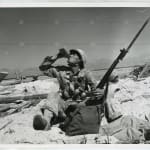-
Artworks
Open a larger version of the following image in a popup: "Time Out” A Marine draped with hand grenades and extra clip of ammunition takes time out for a drink from his canteen on Tarawa, November 1943.
Open a larger version of the following image in a popup:
"Time Out” A Marine draped with hand grenades and extra clip of ammunition takes time out for a drink from his canteen on Tarawa, November 1943.
Open a larger version of the following image in a popup: "Time Out” A Marine draped with hand grenades and extra clip of ammunition takes time out for a drink from his canteen on Tarawa, November 1943.
Open a larger version of the following image in a popup:
"Time Out” A Marine draped with hand grenades and extra clip of ammunition takes time out for a drink from his canteen on Tarawa, November 1943.
Open a larger version of the following image in a popup: "Time Out” A Marine draped with hand grenades and extra clip of ammunition takes time out for a drink from his canteen on Tarawa, November 1943.
Open a larger version of the following image in a popup:
"Time Out” A Marine draped with hand grenades and extra clip of ammunition takes time out for a drink from his canteen on Tarawa, November 1943.
Open a larger version of the following image in a popup: "Time Out” A Marine draped with hand grenades and extra clip of ammunition takes time out for a drink from his canteen on Tarawa, November 1943.
"Time Out” A Marine draped with hand grenades and extra clip of ammunition takes time out for a drink from his canteen on Tarawa, November 1943.
"Time Out" Marine draped with hand grenades and extra clip of ammunition takes time out for a drink from his canteen on Tarawa., 1943
Original vintage photograph. Watermarks do not appear on the actual photograph.10 x 8 in
25.4 x 20.3 cmPhoto by Defense Department, November 1943PH8330Copyright The Defense DepartmentCurrency:Further images
Excellent quality original photograph by Defense Department, one of the best I have seen! The Battle of Tarawa was fought on 20–23 November 1943 between the United States and Japan...Excellent quality original photograph by Defense Department, one of the best I have seen!The Battle of Tarawa was fought on 20–23 November 1943 between the United States and Japan at the Tarawa Atoll in the Gilbert Islands, and was part of Operation Galvanic, the U.S. invasion of the Gilberts
The objective for the invasion of Tarawa was the main island of Betio. It was the only island out of nineteen smaller islands that held Japanese forces. Tarawa also possessed an airfield, though was very heavily fortified. The commander of the garrison on Tarawa was admiral Keji Shibasaki. Among the other defenses, there were a number of Type 95 Ha-Go Tanks, anti-vehicle mines, light machine gun emplacements, barbed wire, and log barriers. American planners believed that the coral reef where they had chosen to land would not be a problem to landing craft because of high tide.
The battle began at about 4:00 AM off the beach of Betio. The United States Navy and aircraft bombarded the Atoll of Tarawa, hoping to lighten the defenses theJapanese had set up. United States LCVPs and LVTs began to deploy about two hours after the initial bombardment and most marines thought the Japanese forces were decimated. The marines soon hit a major problem; they came at low tide and most of the landing craft were stuck on the reef. Japanese artillery immediately opened fire and many landing craft were destroyed before getting anywhere close to the beach. The marines were forced to wade ashore and were facing severe machine gun fire as they were doing this. In order to establish a beachhead, United States forces sent more and more marines in landing craft. Eventually a beachhead was established, but the marines still had to fight against Japanese pillboxes. US forces pushed through Japanese lines at about midday, although they still hadn't made much progress. Early the next day, marines had managed to push their way to the airfield. Tanks, artillery, and other support came later that day. United States intel said that Japanese forces were heading to another islet in Tarawa but they were soon eliminated by elements of the 6th Marines. Keji Shibasaki was one of these casualties. The battle raged for about 1 and half more days. It ended after a final Banzai charge was repelled by marines. The island still had some Japanese resistance, but these pockets were later dealt with.
Provenance
Stamped and dated on the back side by Defense Department November 1943.












